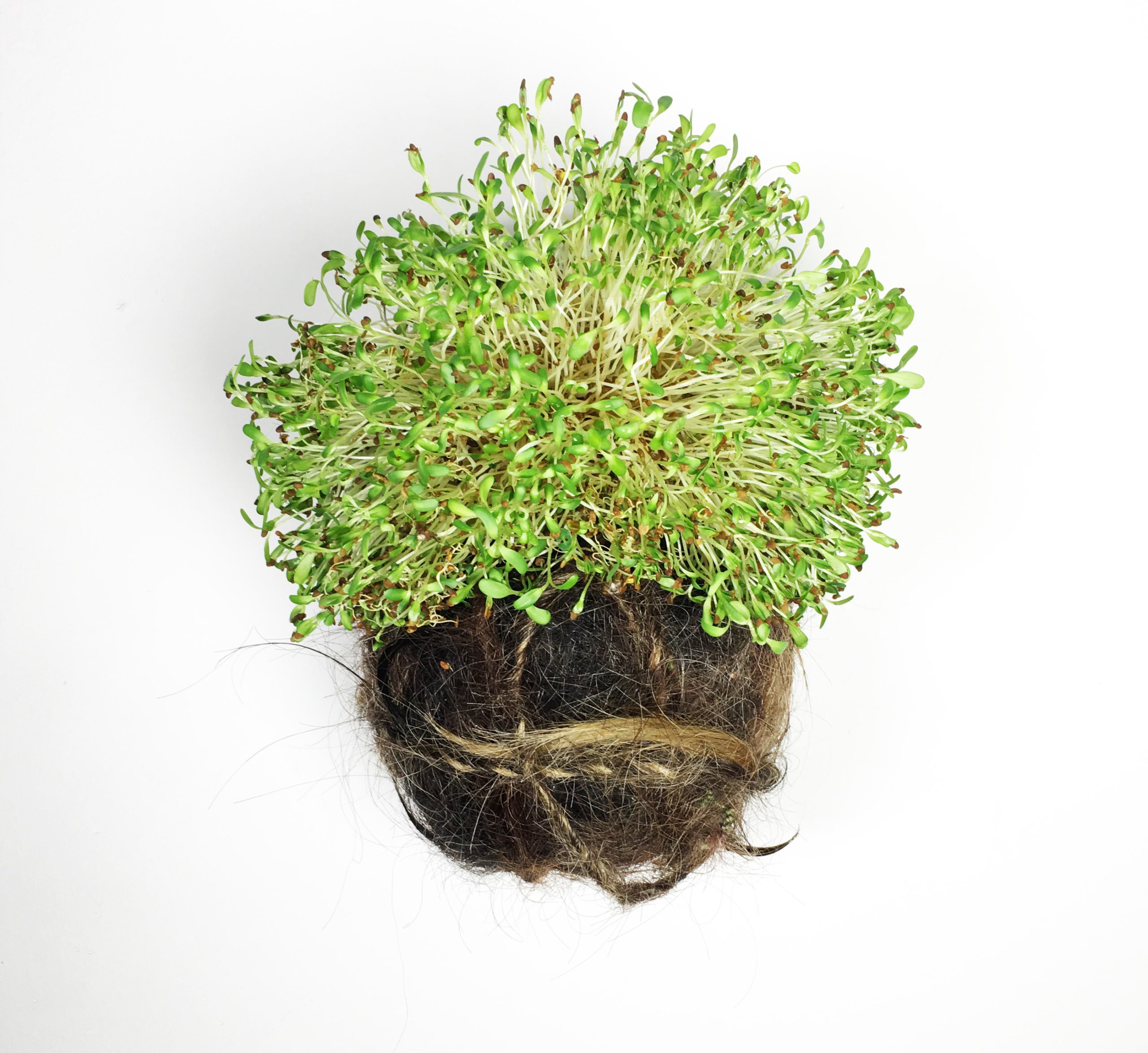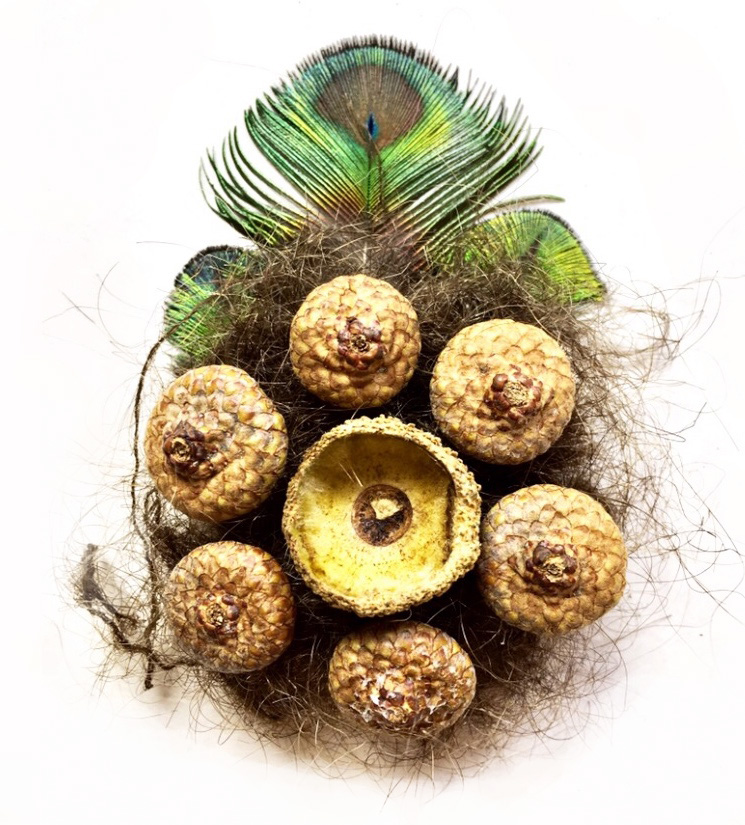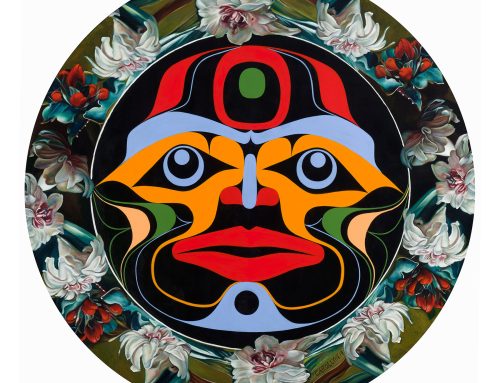Project Description

Untitled, 17″ x 5″ x 3″, 2020, hand-spun human hair, squirrel hair, lichen (sustainably foraged from ground after windstorm), reflective light found attached to discarded car bumper in the ditch, found pompom on street . 14″ x 3.5″ 2
My research into the structures of power and division between humans and non-humans led to an investigation into the colonial history of MEE-qan (Beacon Hill Park) in Victoria, BC. The first Indian (blue) peafowl was brought to the park by colonial settlers from the Indian subcontinent in 1891. These experiments started with foraging for remnants on the ground, gifts of dyed blue and red human hair, salt and borax crystals, and alfalfa sprouts to represent a symbiosis of the park where I collected them. These assemblages represent the intertwining histories and a shared habitat of the peafowls, humans, grey squirrels and Garry oak trees, human lunchables, and anthropogenic materials. I also experimented with different ways to visually represent the combination of human and non-human DNA. Salt is used to extract DNA during genome testing or to extract the phenotypes. I wanted to see what the crystallization of different materials could tell me after being dipped into the salt bath and mixed with my spit.
Notes:
Eastern grey squirrels were first introduced into MEE-qan in 1945 by Park Administrator W. H. Warren and the Parks Committee. “Some residents opposed the introduction of non-native animals at the time; they wanted to protect and promote native wildlife such as the native Red squirrel (Tamiasciurus hudsonicus). The animals released in the park in 1945 completely disappeared” (Ringuette). Grey squirrels living in the park and throughout the Victoria region today are most likely descendants of squirrels acquired from Ontario in the fall of 1966 by white settler Dirk van der Meer, a long-time ‘conservationist’ in Metchosin, who owned the Vandermeer Game Farm. These animals “escaped accidentally shortly thereafter,” according to a 1975 article in the Provincial Museum publication Syesis by C. J. Guiguet (1975).
The Assistant Deputy Minister of BC wrote to Beacon Hill Park Committee Chairman in 1945 complaining about the parks recent import of grey squirrels being a concern. This would suggest the city of Victoria was responsible for the original import to the south island. The introduction of Eastern grey squirrels (Sciurus carolinensis) into Beacon Hill Park in 1945 sparked letters to the Park Committee. Some citizens and an official of the provincial government opposed the introduction of the non-native animal and favoured protecting and promoting native wildlife. W. H. Robertson, Asst. Deputy Minister of B. C., wrote D. D. McTavish, Park Committee Chairman, on December 4, 1945: “You recently imported into the city some grey and other squirrels which are not native to the Province…the grey squirrel…when imported into other provinces [has] been of extreme annoyance.” (CRS 106, 12 F 2)
Beacon Hill Park Superintendent W. H. Warren, who promoted the introduction of the squirrels, fielded a supportive letter from Woodland Park in Seattle and from the Superintendent of Vancouver’s Stanley Park, who said grey squirrels introduced into Stanley Park “10-15 years ago” were not a problem. In fact, he said “we are considering planting more nut trees…to encourage the squirrels to spread and multiply…” (CRS 106, 12 F 2) It has been said that during the environmental movements of the 1960’s and 70’s a love for squirrels soon took a sour turn as they appropriated human infrastructure, nesting in buildings and eating flower bulbs. Their ability to populate and survive around humans led them to be thought of as pests. Locally, they also became a scapegoat for a decline in the population of Red squirrels and Douglas squirrels, which as native to the area. Even though studies have concluded that humans’ destruction of native squirrel habitats and loss of coniferous trees as more likely the cause, grey squirrels remain listed as an invasive species in British Columbia.
Though not present in Beacon Hill Park, native Vancouver Island squirrels–noisy Red squirrels with distinctive ear tufts–are still seen and heard in many areas of southern Vancouver Island. Little research has focused on whether or not introduced grey squirrels have displaced native squirrels on the Island.
Research on the spread of Eastern grey squirrels and possible effects on native Douglas squirrels in the Greater Vancouver Regional District could be relevant. University of Guelph Masters degree candidate Emily Gonzales reported:
In the five years that I have been studying squirrels, I could not find anything but anecdotal evidence that Eastern grey squirrels are displacing native squirrels in B.C. All three species [Flying, Grey and Douglas squirrels] have coexisted in Stanley Park for over 90 years. Distribution data…shows that native and non-native squirrels coexist in municipalities where native squirrels have their preferred habitat and sufficient resources.
Andrew I. Maher, also of the University of Guelph, concluded: “Douglas squirrel displacement is the result of urbanization, and contrary to popular belief, not related in any way to the invasion of the Eastern grey squirrel.”
Bibliography
Gonzales, Emily K., et al. “Positive relationship between non-native and native squirrels in an urban landscape.” Canadian Journal of Zoology, vol. 86, no. 5, 2008, pp. 356-363, doi.org/10.1139/Z08-006
Guiguet, C. J., 1975. “An Introduction of the Grey Squirrel, Sciurus carolinensis (Gmelin), to Vancouver Island, British Columbia.” Syesis 8:399, 1975.
Margulis, Lynn, and Dorion Sagan, Acquiring Genomes: A Theory of the Origins of the Species, Basic Books, New York, 2003.
Ringuette, Janis. “Grey squirrels introduced”, Beacon Hill Park History, www.beaconhillparkhistory.org/contents/chapter12.htm, 2004.

Protective Gear, Beacon Hill Park (Winter), 2020, found items include foam sleeve, reflector, peafowl feathers. 6″ x 6″ 2″

Semiotic silence A, from the Hologenome Series, 14″ x7″ x 1.25, 2020, spun and knitted human hair, lichen on Garry oak branch (sustainably foraged from ground after windstorm), reflective plastic left by city workers . 6″ x 6″ 2″

Semiotic silence B, from the Hologenomes series, 2020, spun and knitted human hair, reflector, peafowl feathers. 6″ x 6″ 2″

Semiotic silence D, from the Hologenomes series, 2020, found faucet, human hair, sponge, alfalfa sprouts, 8” x 4” x 8”

Semiotic silence C, from the Hologenomes series, 2020, found faucet, human hair, sponge, alfalfa sprouts, 8” x 4” x 4”

Symbiogenetic Mask, Beacon Hill Park (Fall), Victoria BC, 9″ x 11″ x 2.5″, peafowl feathers, squirrel hair, Garry oak tree branches, human hair, salt and Borax crystals, string, yarn, tulle, wool, 2019.

5 from the Park series. Peacock feathers, dyed human hair, untreated human hair, salt and borax crystals, cypress tree, hat pin, 6″ x 3″ x 2″, 2019.











